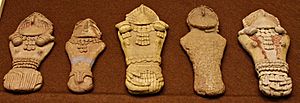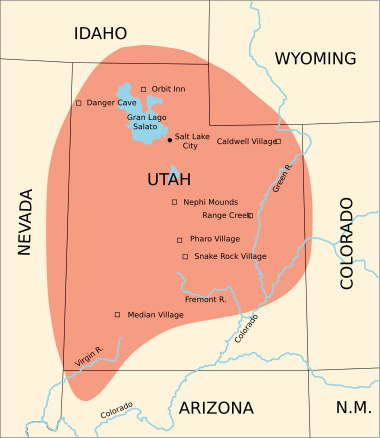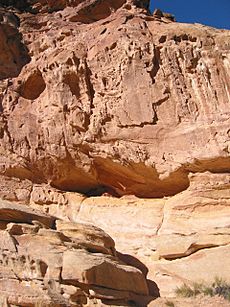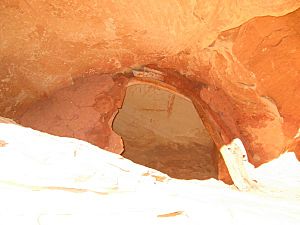Fremont culture facts for kids
The Fremont culture refers to a group of ancient people who lived in parts of what is now the United States. They are named after the Fremont River in Utah, where their old living sites were first found. Local Native American groups like the Navajo and Ute knew about these sites. In Navajo stories, the rock carvings left by these people are said to be from those who lived long before a great flood.
The Fremont people lived in areas of Utah, Nevada, Idaho, Wyoming, and Colorado. They were present from about AD 1 to 1301, which is roughly 700 to 2,000 years ago. They lived near, and at the same time as, the Ancestral Pueblo people to their south, but they were a distinct group.
Contents
Where the Fremont People Lived
The largest known Fremont culture site in Utah is at Fremont Indian State Park. This park is located in the Clear Creek Canyon area of Sevier County. At this site, archaeologists have found thousand-year-old pit houses, rock carvings (petroglyphs), and many other artifacts.
Another important area is Range Creek, Utah, where well-preserved Fremont sites were discovered. Nine Mile Canyon is also famous for its huge collection of Fremont rock art. Other places where Fremont sites have been found include the San Rafael Swell, Capitol Reef National Park, Dinosaur National Monument, Zion National Park, and Arches National Park.
How They Got Their Name
The name "Fremont" was first used by archaeologist Noel Morss in 1931. He wrote a book called The Ancient Culture of the Fremont River in Utah. This name described the tools, art, buildings, and pottery found from this culture.
Before this, in 1776, a Spanish explorer named Fray Escalante called them "Tihuas" or "Tehuas." He thought they might be related to the Tiwa Puebloans of New Mexico. He noticed that the ruins and pottery looked similar to what the Tiwa people made.
Later, in 1871, John Steward wrote in his journal about finding graves. He wondered if they belonged to the "Moquis" tribes, which is another name for the Hopi people. The Ute also called the old inhabitants of village ruins in their land "mocutz."
Today, some experts think it might be better to call them the "Fremont complex." This is because the people might not have been one single, unified group. They may have been different groups with similar ways of life.
The Fremont People's Way of Life


Archaeologists don't fully agree if the Fremont culture was one big group. However, they shared many things in common. The Fremont people were both hunters and gatherers and farmers. They hunted wild animals like deer and rabbits and gathered wild plants. They also grew corn.
Their homes were usually small villages with a few pithouse structures. These were houses dug partly into the ground. They made simple gray pottery and had a special style of basketry and rock art. Most Fremont lived in small family groups. However, some larger villages existed, like one in the Parowan Valley and the Five Finger Ridge site. These larger sites might have been occupied for a long time or by many people at once.
Some researchers believe the Fremont might have started as a group that split off from the Ancestral Pueblo people. However, this idea is still debated among archaeologists.
According to archaeologist Dean Snow, the Fremont people often wore moccasins, like their ancestors from the Great Basin. This was different from the sandals worn by the Ancestral Puebloans. They were part-time farmers who lived in scattered small villages. They never fully stopped hunting and gathering to become full-time farmers. They made pottery, built homes, and stored food. They also grew corn.
The Fremont culture began to decline around 950 CE due to changes in the climate. Many people moved to marshy areas in northwestern Utah, where they lived for about 400 more years.
New Discoveries

The Range Creek Canyon site is a very important discovery for understanding the Fremont culture. It was found in a remarkably untouched state, which gave archaeologists a lot of new information.
When the Range Creek property was first explored in 2004, it was an amazing find. They found pit houses with collapsed roofs, arrowheads, beads, pottery pieces, and stone tools. Human bones were found in rock shelters, and hundreds of unique human figures were carved into the cliff walls. The pit houses were still mostly intact, and storage areas were filled with corn cobs that were a thousand years old.
Research from 2006 showed that the land contained 1,000-year-old small villages of the Fremont people. These people were skilled hunters and farmers who lived mainly in Utah from about 200 AD to 1300 AD before they disappeared.
The exact fate of the Fremont people is still a mystery. It's possible they moved to areas like Idaho, Nebraska, and Kansas. They might have joined the Dismal River culture to the east or the Ancestral Pueblo communities to the south. They could also have been absorbed by the arriving Numic-speaking peoples.
See also
 In Spanish: Cultura de Fremont para niños
In Spanish: Cultura de Fremont para niños




